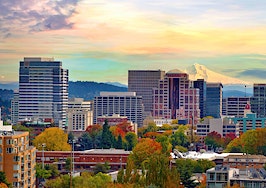This story is featured in Property Portfolio, Inman’s new free weekly newsletter. Every Tuesday, we’ll explore the overlapping worlds of real estate professionals and the fast-growing property investment and management sector. Sign up to receive Property Portfolio here.
Rents are climbing and more higher-income Americans are choosing to lease rather than buy, but while those conditions are a boon to investors many middle-income earners are nevertheless facing a lack of housing supply.
New research from data firm CoStar, which was shared this week with Inman, paints a picture of an overall booming U.S. rental industry that has nevertheless seen uneven growth across different parts of the market. For starters, much of the multifamily housing being built today tends to be high-end luxury units.

Michal Cohen
“There’s something like 660,000 units under construction across the nation,” Michal Cohen, CoStar’s vice president of advisory services, told Inman. “But by all measures, the vast majority of that product is what we consider to be four and five star, or very high quality.”
Cohen described this type of housing as amenity-rich and well-located. So, developers have gone into pricy cities such as Los Angeles and New York and built high-end units with top-of-the-line finishes and other perks. It’s the type of housing that appeals to well-paid and well-educated workers, and tends to represent a sweet spot for developers who need to make a return.
“One of the reasons you’ve seen a wave of luxury product particularly in urban cities,” Cohen added, “is that land is very expensive and construction is very expensive.”
In many ways, the production of this kind of housing is a good thing. Cohen said that in places where the supply of housing is low, for example, adding these kinds of units should help meet demand. CoStar’s research also indicates that the number of renter households in the U.S. has grown the most among those earning more than $100,000 per year.
And those renters are being attracted to the locations and benefits of living in well-connected urban hot spots.

A newer high-end residential building in downtown Los Angeles. | Credit: Jim Dalrymple II
But there are disadvantages to this trend as well.
Cohen said that the luxury units being built today are unlikely to “filter” down the market as they age. The concept of filtering is often debated in urban planning and affordable housing circles, and the idea is that older units become less desirable and thus more affordable over time. Those who see filtering as both significant and positive argue that today’s luxury units are the middle-class housing of tomorrow.
But Cohen said that he doesn’t expect filtering to happen on a significant scale with many new units thanks to their sizes, amenities and locations — all of which aren’t conducive to becoming future workforce or family housing.
And speaking of workforce housing — or housing for people like teachers and firefighters who earn middle-class salaries — Cohen also said that there simply isn’t enough of it.
“Occupancies are higher for workforce housing than for luxury product,” he explained. “And you’re generally seeing rent growth that is stronger for workforce housing. That is a function of the lack of options that workforce renters tend to have.”
In fact, CoStar found that since 2015 rent has grown by about 4 percent each year, which is between 1 percent and 1.5 percent more than incomes.
Cohen was not optimistic that the current burst of construction, which will ultimately see hundreds of thousands of new units finished, will significantly help middle-income renters. And as a result, many of those renters are fleeing to more affordable cities such as Denver, Phoenix and Austin.
“These markets should continue to over perform,” Cohen said.
CoStar specifically expects rent growth to be the strongest in the South in the near future thanks to, among other things, an expanding working-age population and corporate relocations in that region.
The current tendency of people to move out of pricy states as they face affordability woes and into more affordable ones is well-documented, and Cohen said it is typical of what happens as an economic cycle reaches its high point.
Additionally, Cohen noted that there are ongoing legislative responses to the lack of housing for middle and lower-income earners. California, for example, has seen a battle this year over both rent control and housing density bills, and other regions including Oregon have undertaken drastic efforts to boost their housing supply.

A new, well-located apartment building in downtown Los Angeles. | Credit: Jim Dalrymple II
All of this represents something of a two-edged sword: On the one hand conditions are tough and getting tougher for renters, but on the other those people who can afford to step onto the investment ladder stand to make reliable returns as rents continue to rise.
“Landlords are thrilled at the manner in which the multifamily market has been performing,” Cohen added.
The question now, though, is if those conditions will persist. Cohen pointed to ongoing trade tensions and some warning signs in the global economy and noted that there are “definitely some very scary things that go bump in the night.”
Still, he added, multifamily real estate tends to be a comparatively safe investment, and CoStar’s data doesn’t indicate a downturn immediately on the horizon.
“Our view is that the cycle probably has some more room to run,” he added. “We don’t think a recession is imminent.”
How do you stay ahead in a changing market? Inman Connect Las Vegas — featuring 250+ experts from across the industry sharing insight and tactics to navigate threat and seize opportunity in tomorrow’s real estate market. Join more than 4,000 top producers, brokers and industry leaders to network and discover what’s next, July 23-26 at the Aria Resort. Hurry! Tickets are going fast, register today!
Thinking of bringing your team? There are special onsite perks and discounts when you buy tickets together. Contact us to find out more.













